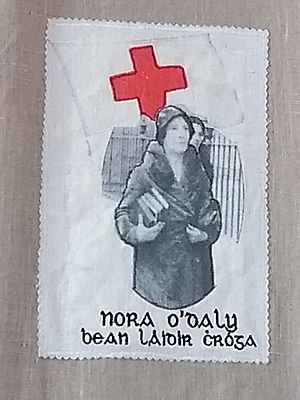Nora O'Daly facts for kids
Quick facts for kids
Nora O'Daly
|
|
|---|---|
| Born |
Nora Margaret Mary Gillies
12 August 1883 Terenure, Dublin, Ireland, United Kingdom
|
| Died | 10 May 1943 (aged 59) Jobstown, Dublin, Republic of Ireland
|
| Nationality | Irish |
| Organization | Cumann na mBan |
| Spouse(s) |
Séamus (James) O'Daly
(m. 1910) |
| Family | Paddy Daly (brother in law) |
Nora O'Daly (1883–1943) was a brave Irish nationalist, a writer, and someone who worked to help workers. She was a member of Cumann na mBan, a group for women who wanted Ireland to be free. Nora played a part in the Easter Rising in 1916. After the Rising, she was one of 77 women who were arrested and held in Richmond Barracks. Later, she wrote a book about her experiences during this important time in Irish history.
Nora's Early Life
Nora Margaret Mary Gillies was born on August 12, 1883. Her parents were John Malcolm and Alice Maud Gillies. She grew up in Terenure, a part of Dublin. Her father moved to Ireland from Scotland in 1878. He worked as a manager for a newspaper called the Freeman's Journal.
Nora's parents were both Presbyterian. However, Nora and six of her seven brothers and sisters later chose to become Catholic. She also joined the Gaelic League with her sisters, Kathleen and Daisy. This group worked to keep Irish language and culture alive.
In 1910, Nora and her sister Daisy had a double wedding. Nora married James (Séamus) O'Daly, and Daisy married James's brother, Paddy O'Daly. James O'Daly was an engineer and also an Irish nationalist. He joined the Irish Volunteers, a group of armed men. Nora and James had four children together.
Role in the Easter Rising
In 1914, Nora O'Daly helped start the Fairview branch of Cumann na mBan. This group worked closely with the 2nd Battalion of the Irish Volunteers. Here, Nora learned important skills. She learned first aid, how to clean and aim a rifle, and how to march. These skills would help the men of the 2nd Battalion.
Nora's home in Clontarf was used to hide weapons and bullets. These were kept ready for the planned Rising. Nora also helped gather secret information. She worked with another Cumann na mBan member, Bridget Murtagh. They collected details about the Magazine Fort in Phoenix Park. They found out how the fort was set up, how many soldiers were there, and when the guards changed. This information was for a planned attack.
On Easter Monday in 1916, Nora and other Cumann na mBan members went to St Stephen's Green. They were under the command of Michael Mallin and Countess Markievicz. Nora spent the week of the Rising at the Royal College of Surgeons in Ireland. There, she gave first aid to the injured. She worked with Madeleine ffrench-Mullen and Rosie Hackett. Nora helped Margaret Skinnider, who was the only woman injured during the Rising. Nora said Margaret was very brave despite her serious wounds.
After the Irish rebels surrendered, Nora was held at Richmond Barracks. Then she was moved to Kilmainham Gaol. Most of the women prisoners were let go on May 8 or 9. However, Nora, Madeleine ffrench-Mullen, and Nellie Gifford were kept longer. The authorities thought they were dangerous. Nora later wrote about her time in Kilmainham.
After the Rising, Nora joined the main branch of Cumann na mBan. She helped to reorganize the group. She also raised money for a fund to help Irish families. Nora was active in stopping forced military service. She also campaigned for the Sinn Féin political party in the 1918 election.
Nora O'Daly is remembered in the 77 Women commemoration quilt. This special quilt was made by The Yarn Project. It honors all the women who were arrested and held in Richmond Barracks after the Rising.
War of Independence Work
During the Irish War of Independence, Nora O'Daly served as a judge. She worked in the Republican Courts in the Fairview / Ballybough area. These courts were often raided by the British authorities, and people working there were arrested.
Despite her home being searched, Nora ran a safe house. This meant she hid people who were wanted by the authorities. She gave shelter to Joe Leonard. He was involved in the killing of 14 British agents on November 21, 1920. This day became known as Bloody Sunday. Nora's brother-in-law, Paddy O'Daly, was also part of the group that carried out these actions. This group was called 'The Squad' and was led by Michael Collins. The British police, known as the Black and Tans, called Nora O'Daly "a dangerous woman."
Later Life and Legacy
Nora O'Daly did not take part in the Irish Civil War. After the Irish Free State was created, she worked as a secretary. She helped to close down the Dáil Courts. She also joined the Irish Women Workers' Union (IWWU). Here, she worked hard to improve the rights of women workers.
Nora loved Irish literature throughout her life. She wrote poems and stories, including her book about the Easter Rising. In 1926, she published an article called 'The Women of Easter Week; Cumann na mBan in Stephen's Green and in the College of Surgeons'. It appeared in An tÓglach, which was the magazine of the Irish Free State army.
Nora O'Daly passed away on May 10, 1943, at the age of 59. She died at her home, 'Clooncoora', in the Jobstown area of southern County Dublin.


